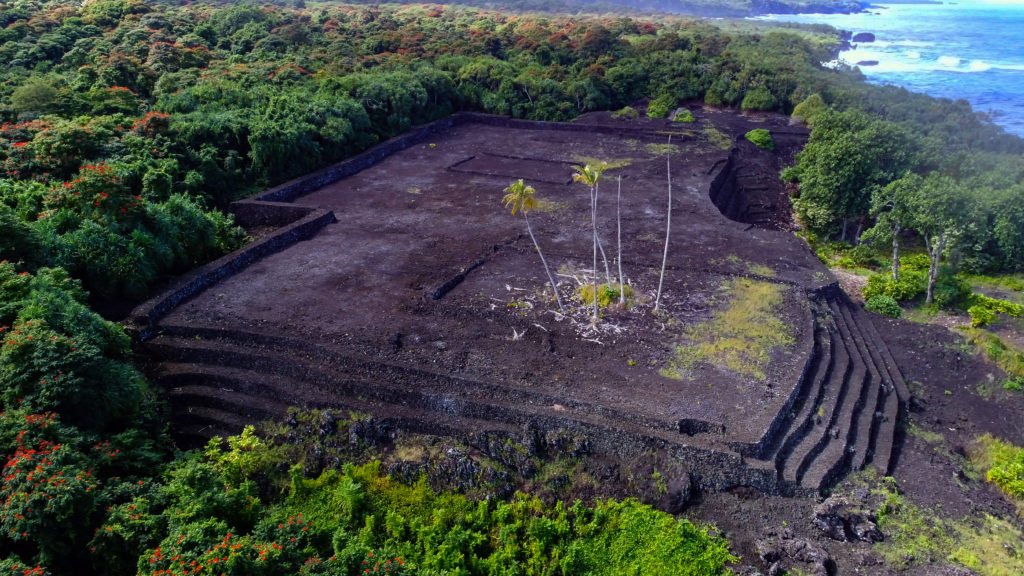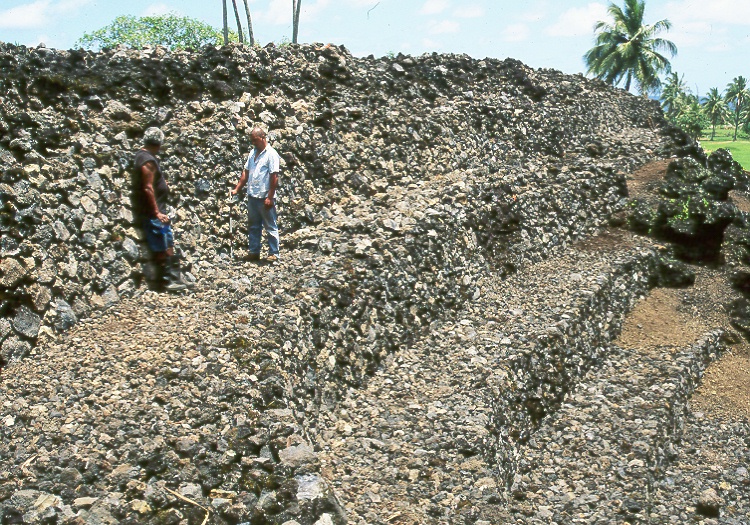Two decades after restoration, reflections on Pi‘ilanihale Heiau Rising
By Chipper Wichman, Ph.D., FLS, NTBG President with Mike Opgenorth, Director of Kahanu Garden and Preserve
This is a story of restoration, reconciliation, and respect. It’s the story of how NTBG grew as an organization, mended old fences, and built new relationships. This is the story of the restoration of the Pi‘ilanihale Heiau, Hawai‘i’s largest ancient stone structure and a place of deep cultural and spiritual importance.
The Pi‘ilanihale Heiau is a registered National Historic Landmark and, more importantly, it is the piko (cultural center) of Kahanu Garden on the Hāna Coast of Maui’s north shore.
In the late 1990s, the Kahanu-Uaiwa-Matsuda-Kumaewa family, who along with Hāna Ranch, had gifted the land where Kahanu Garden was started, had grown frustrated because NTBG had not completed restoration of the heiau within the originally agreed to time frame.
In February 1997, I was serving as Director of the Limahuli Garden and Preserve on Kaua‘i’s north shore when news came of the sudden passing of NTBG’s director Dr. William Klein. Within days, the Garden’s Chairman of the Board of Trustees called and asked if I would accept the role of Kahanu Garden Director in addition to my duties as Limahuli Garden Director.
As both gardens were in remote communities on different islands, the decision was not easy. Simply commuting from Hā‘ena on Kaua‘i to Hāna on Maui would be demanding, but beyond the travel logistics, there was the question of addressing the complicated and strained relationship that had developed between the Garden and the Hawaiian community in Hāna over the past decade.
The Garden’s promise to restore the heiau was the primary reason the property was given to NTBG and we had not fulfilled our commitment. Although the task before us was daunting, my wife Hau‘oli and I felt as though a voice was calling us to accept the challenge and make things pono (right). Recognizing this unique opportunity to reconcile our relationship with the Hāna community and reassess the role of the Garden, I agreed to become the director. By accepting the position, I knew I was committing to oversee the completion of the heiau restoration, a project that could take three to five years and which would require significant fundraising.
But the biggest challenge was finding the right people to work on this massive project. I immediately thought of Francis Palani Sinenci who I’d met years earlier when he visited Limahuli Garden with a group of Maui elders. After having seen how Francis, who was born and raised in Hāna, interacted with the community and could conduct the traditional protocols of a Hawaiian warrior, I knew Francis had the passion, dedication, and cultural foundation needed to restore Pi‘ilanihale Heiau.
From the outset, Francis and I agreed it was critical for the heiau to be restored by stone masons who were from Hāna. Working with thousands of lava rocks, many weighing a hundred or more pounds, was physically grueling, but embracing this kuleana (responsibility) was also culturally empowering and fulfilling.
Francis put together a crew of men from Hāna that included Jack Kahanu-Uaiwa, and Tony Helekahi, along with two of Francis’s brothers, Peter and Sebastian (Igot). The stone masons worked closely with archaeologists Dr. Yosihiko Sinoto of Bishop Museum and Dr. Eric Komori from the Hawai‘i State Historic Preservation Division.
The restoration of the heiau, with lava rock walls rising 50 feet on the north side, was based on a five-phase plan developed by Dr. Sinoto and bolstered by a quarter century’s worth of initial restoration work conducted by Francis Kikaha Lono, affectionately called “Uncle Blue.”
Uncle Blue was the first employee hired by NTBG to work at Kahanu Garden in 1972 and a direct descendant of the paramount Mōʻī (High chief or King) Piʻilani who lived on Maui in the 1500s. It is Pi‘ilani who is credited with completing a major phase of the heiau’s construction. He is also revered as establishing peace across the island of Maui during his reign.
Pi‘ilanihale Heiau, which had been damaged by decades of grazing cattle trampling the site and the unchecked spread of wild vegetation, was badly in need of restoration. And even as dedicated as Uncle Blue and his family were to rebuilding dry stack lava rocks walls, the effort would require the help of a full crew.
As Uncle Blue, Francis, and the crew began the monumental task before them, they carefully employed traditional cultural protocols when removing rubble, locating niho (foundation stones), and rebuilding the terrace walls. When the crew needed scaffolding, they built their own from material in the garden. As the months passed, the pace of work quickened and the crew’s connection to their ancestors and the heiau strengthened.
Francis noted that only with laulima (many hands) could an undertaking of this scale be successful. In restoring the heiau, he said, he could complete the fifth major stage of Hawaiian life (teaching, farming, building, combat, and heiau restoration) which was the final ‘aho (lashing), that bound together a long life of cultural practices.
For Francis and the others, the restoration was not simply a job. The work was a manifestation of their cultural pride and a physical demonstration of their respect for their ancestors. Fueled by a quiet, inner pride, their work advanced at a rate no one could have foreseen and, in less than a year’s time, the restoration was complete.
On April 10, 1999, Hāna’s community gathered to celebrate the completion with traditional protocols and the chanting of the sacred genealogy of high chief Piʻilani, culminating an effort that had begun nearly 30 years earlier. Today, some two decades after the restoration, we see how the project gave rise to a new period of growth and success. The restored heiau rises high above Kahanu Garden and the surrounding landscape, a silent symbol that reminds us of the sacredness of this most special of places.
Reflecting on all that has been achieved since the restoration, Kahanu Garden and Preserve Director Mike Opgenorth described the garden as a place cared for by generations of those dedicated to aloha ʻāina (deep love of the land). “There is no mistake we are guided by those who came before us. The heiau restoration was the most significant accomplishment since NTBG began stewardship of Kahanu Garden,” Mike said. “We will continue to care for the heiau in perpetuity and increase awareness of the biological and cultural resources that surround us. There is so much to still learn about Piʻilanihale Heiau and all that grows here.”


